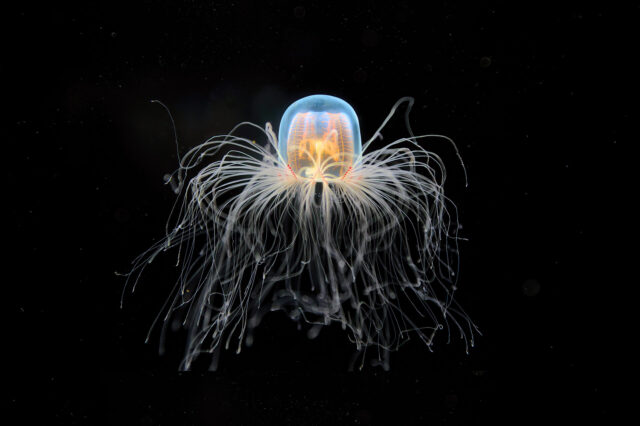Month: April 2012
实验室
Jellyfish

沉痛悼念方励之校长
Fang Lizhi
| Fang Lizhi 方励之 |
|
|---|---|
 |
|
| Born | February 12, 1936 Beijing, China |
| Occupation | Physicist |
| Known for | 1986 Student Demonstrations |
Fang Lizhi (simplified Chinese: 方励之; traditional Chinese: 方勵之; pinyin: Fāng Lìzhī; born February 12, 1936) is a professor of astrophysics and former vice-president of the University of Science and Technology of Chinawhose liberal ideas inspired the pro-democracy student movement of 1986-87 and, finally, the Tiananmen Square protests of 1989.[1] Because of the first, he was expelled from the Communist Party of China in January 1987.[2]
During the Anti-Rightist Campaign Fang was expelled from the Communist Party of China and was imprisoned for a year during the Cultural Revolution for his “reactionary activities”.[3]:428 Namely publishing an article critical of the government’s policies on science education.
Contents |
Political Activism
Fang gained fame and notoriety after his essays were collected and distributed by the Communist Party of China to many of its regional offices, with the directive to its members to criticize the essays. As the story goes, many who read his essays found them to be thought-provoking, and Fang was inadvertently provided a platform for his views.
Fang was one of the three main leaders who, in December 1986, organized student demonstrations in a over a dozen Chinese cities in order to agitate for greater economic and political freedoms. (The other two senior leaders were Liu Binyan and Wang Ruowang). Deng Xiaoping disliked all three leaders; and, after two straight weeks of student demonstrations, directed then-CCP General Secretary Hu Yaobang to expel them from the Party, but Hu refused. Because of his refusal, Hu was dismissed from his position as General Secretary in January 1987, effectively ending his period of influence within the Chinese government.[4]
1989 Democracy Movement & Exile
During the Tiananmen Square protests of 1989, Fang and his wife, Li Shuxian, were granted asylum at the U.S. embassy in Beijing. They entered the embassy on June 5, 1989 (the day after the government began its repression of the protests). During his time there, Fang wrote an essay titled The Chinese Amnesia,[5] criticizing the Chinese Communist Party‘s repression of human rights and the outside world’s turning a blind eye to it.[6] Fang’s continued presence in the US Embassy following the protests became, according to Ambassador James Lilly, “a living symbol of our [US] conflict with China over human rights.”[3]:429
Fang and his wife remained in the US Embassy until June 25, 1990 when they were allowed by Chinese authorities to leave the embassy and board a U.S. Air Force C-135 transport plane to Britain.[7] This resolution came about after confidential negotiations between Henry Kissinger (acting on behalf of US President George H.W. Bush) and China’s paramount leader Deng Xiaoping [3][6] as well as a meaningless “confession” by Fang (boilerplate “verbiage” common in Communist ideology that in no way admitted wrong),[8] an attempted intervention by US National Security Adviser Brent Scowcroft and an offer from the Japanese government to resume loans to the PRC in return for “the Fang Lizhi problem [being] solved”.[8]
In 1989, he was a recipient of the Robert F. Kennedy Human Rights Award.
Later life
After some time at Cambridge University and Princeton, Fang later moved to Tucson, where he works as Professor of Physics at the University of Arizona.
In campus speeches Fang has spoken on topics such as human rights and democracy as matters of social responsibility. He also served as a board member and co-chair of Human Rights in China.[6]
See also
References
- ^ Yam, P. (1994) Profile: Fang Lizhi – Fundamental Rights, Fundamental Physics, Scientific American 270(5), 39-40.
- ^ Letters from the Other China – The New York Review of Books
- ^ a b c Kissinger, Henry (2011). Henry Kissinger: On China. United States: Allen Lane. ISBN 978-1-846-14346-5.
- ^ Lee, Khoon Choy. Pioneers of Modern China: Understanding the Inscrutable Chinese. Singapore: World Scientific Publishing. 2005. pp.313-314. ISBN 9812564640.
- ^ The Chinese Amnesia, New York Review of Books, 1990.
- ^ a b c Spence, Jonathan D. Kissinger and China, The New York Review of Books, June 2011.
- ^ Lilley, James. China Hands. New York: Public Affairs, 2004. ISBN 1-58648-343-9.
- ^ a b My “Confession”, Fang Lizhi, translated by Perry Link. The New York Review of Books, 2011.




